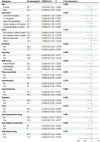Fermented dairy products intake and stroke risk: analyses of NHANES 2007-2018 data
- PMID: 40761346
- PMCID: PMC12320699
- DOI: 10.3389/fnut.2025.1593174
Fermented dairy products intake and stroke risk: analyses of NHANES 2007-2018 data
Abstract
Background: Stroke ranks among the main diseases resulting in death and disability, imposing a heavy burden on both the country and individuals. Healthy foods can effectively prevent the occurrence of stroke, and fermented dairy products are among them. However, in previous studies, the correlation between stroke and fermented dairy products remains controversial.
Methods: The intake of fermented dairy products and the identification of stroke both originated from the data of the NHANES database from 2007 to 2018. This study used a weighted regression model to analyze the association between the total intake of fermented dairy products and the intake of various types of fermented dairy products (yogurt, cheese and buttermilk) and stroke, and conducted subgroup analyses and interaction tests.
Results: This study included 27,487 American adults, of whom 2.9% had suffered from a stroke. The results of regression analysis indicated that total intake of fermented dairy products and yogurt intake were negatively correlated with stroke. For total intake, after adjusting for all confounding variables, the results revealed that every 50 g rise in intake led to a 7% decline in the stroke risk (OR = 0.93, 95% CI: 0.88-1.00). Meanwhile, when compared to participants having no consumption of fermented dairy products, those with a low intake had a 21% lower probability of stroke (OR = 0.79, 95% CI: 0.66-0.95). Subgroup analysis showed that smoking interacted with stroke and fermented dairy products (p = 0.047). For yogurt, after adjusting for all confounding variables, the results indicated that for every 50 g rise in intake, the probability of stroke declined by 7% (OR = 0.93, 95% CI: 0.86-1.00). However, only high intake of yogurt was associated with a protective effect against stroke, and this relationship remained stable across three models (Model I: OR = 0.49, 95% CI: 0.33-0.75; Model II: OR = 0.50, 95% CI: 0.33-0.75; Model III: OR = 0.62, 95% CI: 0.40-0.96). In contrast, no significant associations were found between cheese and buttermilk intake and stroke risk.
Conclusion: This study discovered that, among American adults, the total quantity of fermented dairy products as well as yogurt had an inverse correlation with the risk of stroke, while this correlation did not exist for cheese or buttermilk.
Keywords: NHANES; adult; fermented dairy products; stroke; yogurt.
Copyright © 2025 Ma, Miao and Wu.
Conflict of interest statement
The authors declare that the research was conducted in the absence of any commercial or financial relationships that could be construed as a potential conflict of interest.
Figures
Similar articles
-
Impact of residual disease as a prognostic factor for survival in women with advanced epithelial ovarian cancer after primary surgery.Cochrane Database Syst Rev. 2022 Sep 26;9(9):CD015048. doi: 10.1002/14651858.CD015048.pub2. Cochrane Database Syst Rev. 2022. PMID: 36161421 Free PMC article.
-
Sertindole for schizophrenia.Cochrane Database Syst Rev. 2005 Jul 20;2005(3):CD001715. doi: 10.1002/14651858.CD001715.pub2. Cochrane Database Syst Rev. 2005. PMID: 16034864 Free PMC article.
-
Smoking cessation for secondary prevention of cardiovascular disease.Cochrane Database Syst Rev. 2022 Aug 8;8(8):CD014936. doi: 10.1002/14651858.CD014936.pub2. Cochrane Database Syst Rev. 2022. PMID: 35938889 Free PMC article.
-
Association between dairy products intake and frailty transitions in older adults: The InCHIANTI cohort study.J Nutr Health Aging. 2025 Mar;29(3):100482. doi: 10.1016/j.jnha.2025.100482. Epub 2025 Jan 14. J Nutr Health Aging. 2025. PMID: 39813858 Free PMC article.
-
Nutritional interventions for survivors of childhood cancer.Cochrane Database Syst Rev. 2016 Aug 22;2016(8):CD009678. doi: 10.1002/14651858.CD009678.pub2. Cochrane Database Syst Rev. 2016. PMID: 27545902 Free PMC article.
References
-
- GBD 2021 Causes of Death Collaborators . Global burden of 288 causes of death and life expectancy decomposition in 204 countries and territories and 811 subnational locations, 1990-2021: a systematic analysis for the global burden of disease study 2021. Lancet. (2024) 403:2100–32. doi: 10.1016/S0140-6736(24)00367-2 - DOI - PMC - PubMed
-
- Ma Z, He W, Zhou Y, Mai L, Xu L, Li C, et al. Global burden of stroke in adolescents and young adults (aged 15-39 years) from 1990 to 2019: a comprehensive trend analysis based on the global burden of disease study 2019. BMC Public Health. (2024) 24:2042. doi: 10.1186/s12889-024-19551-1, PMID: - DOI - PMC - PubMed
LinkOut - more resources
Full Text Sources





